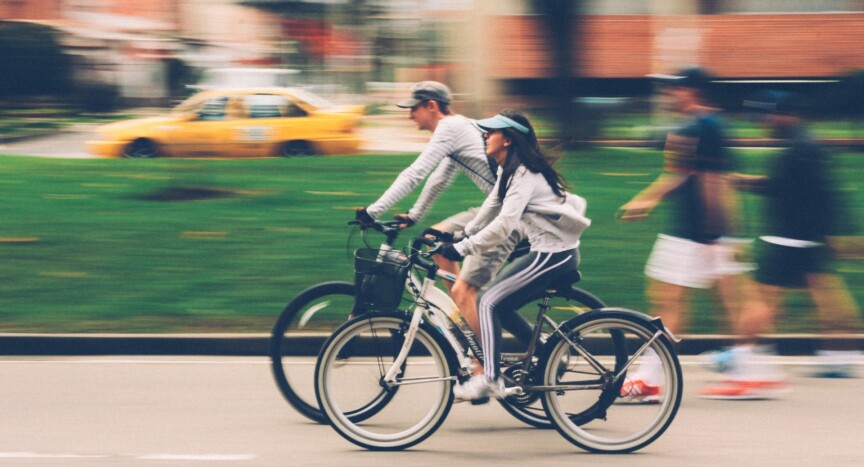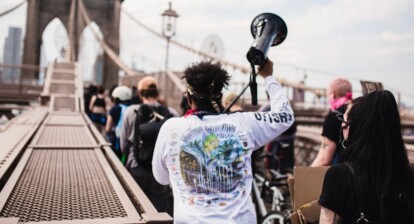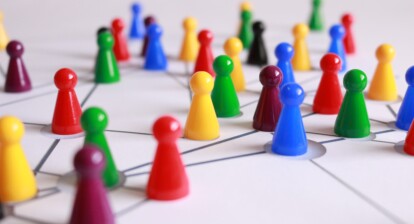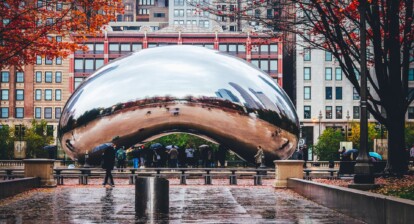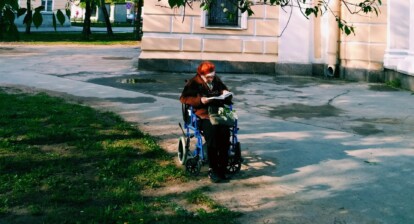Think about your neighbourhood. What places do you enjoy going to? What are your favourite spots? Imagine areas that bring you joy, or perhaps where you feel relaxed. What are you doing there? For me it is a small park within walking distance from my house, there is a little pond and lots of different animals, plants, and walkways. I like to go there to exercise, read, or just escape the noises from a road close to my house. I could walk for hours in the park while listening to my favourite podcast without noticing the time passing. This place always puts me in a good mood.
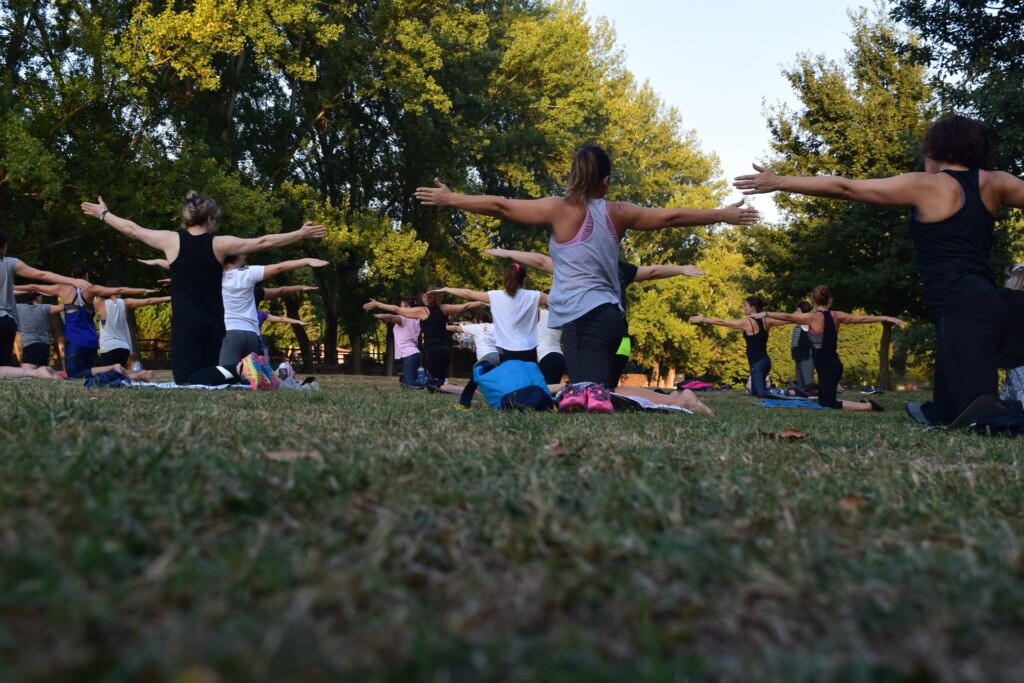
What is around us matters. Whether it is our social or physical context, our surroundings impact our behaviour and decision making. Today, in 2022, we are leading less active lifestyles than ever before. This is well demonstrated as “the Default American lifestyle” [1], which is based on American context, but in my opinion, applies almost everywhere. According to this lifestyle, modern unhealthy ways of living are characterized by high food consumption and the minimization of physical activity. Everything has been made relatively effortless for us through different machines and technology: instead of taking the stairs, we could use the elevator. This way of living surely maximizes our time usage in many ways, but also lowers our activity levels crucially.
This lifestyle of modern times is about more than just change from human to mechanical energy[1], it is about other aspects of our lifestyles that are destructive for our health. Nevertheless, what matters is that the only way of overcoming this ‘normal’ way of living is by taking individual actions: the study[1] demonstrates how education is crucial to obtain necessary knowledge and skills to be able to retain these habits. But why is it sometimes so difficult to not engage in this way of living, even though you might be aware of the negative side effects? Well, like the saying goes: you are what you eat – and likewise, we are what we are surrounded by.
“Like the saying goes: you are what you eat – and likewise,
we engage in what we are surrounded with”
The characters of a neighbourhood affect our actions
The environment and structure of society, such as infrastructure sets the basis for the possibilities to engage in physical, or any other kind of activity. Our environment reinforces our decisions and behaviour: if there is a McDonalds near your house you are more likely to be tempted from time to time to have dinner there rather than cook yourself. If you own a car, it is easier to take that instead of cycling to the store. Therefore, our neighbourhoods are also crucial factors in our decision making. Not only neighbourhood characteristics form the base of opportunities, but also what kind of experiences we can gain from them.
We spend a lot of time in our neighbourhoods, so it is crucial that these places are structured to invite people to be more active; for example, by encouraging the choice of bike over car. The increase in these opportunities gives us healthier options to include in our lifestyles.
Wellbeing through the sense of flow
Furthermore, one way to affect our wellbeing is through engagement in activities that are fulfilling and absorbing [2]. This state of engagement is called ‘flow’ according to Csikszentmihalyi [3] where an activity immerses you completely, creating feelings of happiness, like what walking in the park listening to a podcast does for me. Flow state can turn normal activities interesting, or already enjoyable activities even more rewarding.
A study by Pitt [4] shows how certain places, a community garden for example, can improve wellbeing through a sense of therapeutic experience, together with bodily motion[5]. The therapeutic experience is possible if a state of flow is accomplished, and then this certain activity can lead to improved wellbeing: in their study there were positive effects, especially for elderly people, and people suffering from mental health issues[4]. Places can heal in ways very different to the healing effects of medicine. However, it is not a given that everyone has the opportunities to engage in activities to experience flow, or even experience flow from the same activities[4].
“Places can work as healers,
as much as medicines”
Any place can technically be found therapeutic, or a source of ‘flow’; it is a rather subjective experience. Studies have shown that for example spas [6], and beaches [7] are found therapeutic environments. Also bodily movements can be therapeutic, as well as sources of a flow state, like walking for example [5]. The study by Pitt shows how places besides community gardens can also be found very therapeutic: what matters to the achievement of flow is that these places provide physical and mental distance from stress, and that there is freedom to perform enjoyable activities in these places[4] .
Possible obstacles for flow and activity engagement
The pursuit of the state of flow is dependent on the characteristics of the neighbourhood. Neighbourhoods with poor-quality housing, lack of resources, and other social disorder can lead to stress, which can lead to psychological issues such as depression, regardless of other individual indicators (such as poverty) [8]. Neighbourhood disorder can be for example noise, criminality, drug using, vandalism, or trouble with other people[9]. You can imagine how these stressors can affect your mood, and gradually overall wellbeing, but also, stress prevents the achievement of state of flow[4].

Furthermore, civic engagement is also affected by the characteristics of neighbourhoods:
“Residential type and density, the presence of pedestrian-accessible streets and side-walks, intermixture of commercial and residential spaces, perceptions of safety or danger in public places such as parks, and the availability of dedicated or improvised meeting spaces all contribute to socialization opportunities, familiarity and trust, and neighbourhood civic engagement.” [10] (p.196).
To go further, health inequalities are related to availability of resources in one’s immediate environment [11] and more deprived neighbourhoods not only lack these resources, but also the opportunities that provide the chance to achieve flow state. For example, the distance to green spaces often increases with growing levels of deprivation in an area, or characterized by more safety concerns, damage, and lack of engaging equipment[12].
The feeling of safety as a characteristic is also important for engaging in different activities. As a woman, I am happy that I have enough of a sense of safety in my neighbourhood to go for a walk, even if it is dark outside. This is unfortunately not the case for everyone; and gender is only one impacting aspect. If the neighbourhood environment causes concern for one’s safety, it is more likely that you stay indoors than go for a walk.
The level of engagement, or achievement of flow heavily depends on the organization and characteristics of the neighbourhood. This also has significant effects on wellbeing. What is more, as noted above, health inequalities are related to neighbourhood inequalities, thus it is increasingly important to be aware of how the physical environment reinforces positive or negative actions and behaviours, and what could be done to make the change. Health, physical and mental, could be improved through spatial improvements: perhaps with the help of community gardens, football fields or clean parks, and through them, the achievement of the state of flow.
Referenties
[1] Mirowsky, J., & Ross, C. (2015). Education, Health, and the Default American Lifestyle. Journal of Health and Social Behavior. doi:10.1177/0022146515594814
[2] Schueller, S.M., & Seligman, M.E.P. (2010) Pursuit of pleasure, engagement, and meaning: Relationships to subjective and objective measures of well-being. The Journal of Positive Psychology, 5(4), 253-263. DOI: 10.1080/17439761003794130
[3] Csikszentmihalyi, M. 1997. Flow: The psychology of engagement with everyday life, New York: Basic Books.
[4] Pitt H. (2014). Therapeutic experiences of community gardens: putting flow in its place. Health & Place. P.84-91.
[5] Gatrell, A.C. (2013). Therapeutic mobilities: walking and ‘steps’ to wellbeing and health. Health & Place, 22, 98-106. https://doi.org/10.1016/j.healthplace.2013.04.002.
[6] Little, J. (2013). Pampering, well-being and women’s bodies in the therapeutic spaces of the spa. Social & Cultural Geography, 14(1), 41-58. DOI: 10.1080/14649365.2012.734846
[7] Collins, D., & Kearns, R. (2007). Ambiguous Landscapes: Sun, Risk and Recreation on New Zealand Beaches. In: Williams, A. (Ed.), Therapeutic Landscape. Ashgate, London, pp. 15-32.
[8] Cutrona, C. E., Wallace, G., & Wesner, K. A. (2006). Neighborhood characteristics and Depression. Current Directions in Psychological Science, 15(4), 188–192. https://doi.org/10.1111/j.1467-8721.2006.00433.x
[9] Ross, E. C., Mirowsky, J., Pribesh, S. (2001). Powerlessness and the Amplification of Threat: Neighborhood Disadvantage, Disorder, and Mistrust. American Sociological Review, 66 (4), 568-591.
[10] Patricia L. Price, Christopher Lukinbeal, Richard N. Gioioso, Daniel D. Arreola, Damián J. Fernández, Timothy Ready & María de los Angeles Torres (2011) Placing Latino Civic Engagement, Urban Geography, 32:2, 179-207. DOI: 10.2747/0272-3638.32.2.179
[11] Bernard, P., Charafeddine, R., Frohlich, K.L., Daniel, M., Kestens, Y., & Potvin, L. (2007). Health inequalities and place: A theoretical conception of neighbourhood. Social Science & Medicine, 65(9), 1839-1852. https://doi.org/10.1016/j.socscimed.2007.05.037.
[12] Hoffimann, E., Barros, H., & Ribeiro, A. (2017). Socioeconomic Inequalities in Green Space Quality and Accessibility—Evidence from a Southern European City. International Journal of Environmental Research and Public Health, 14(8), 916. MDPI AG. Retrieved from http://dx.doi.org/10.3390/ijerph14080916

